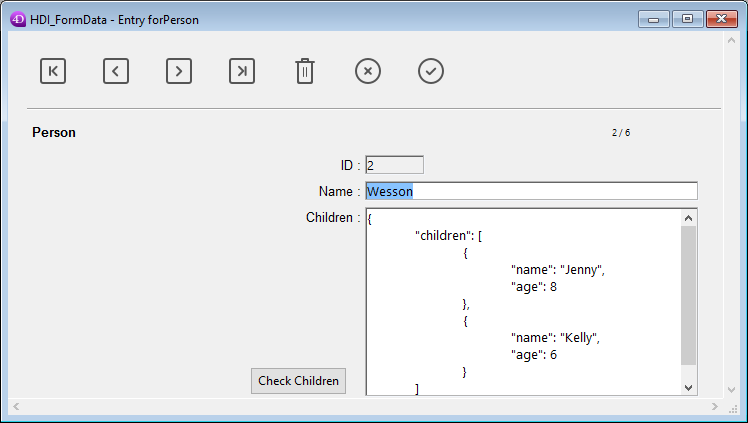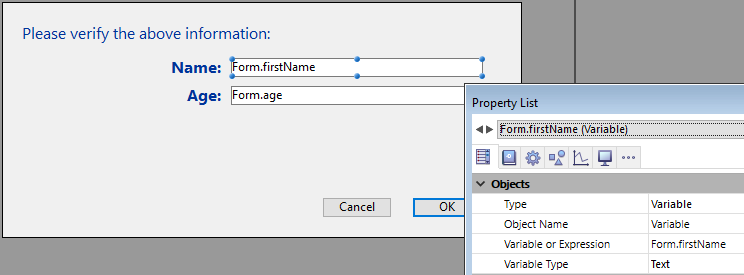Formulaire
Form : Object
| Paramètres | Type | Description | |
|---|---|---|---|
| Résultat | Object | ← | Données du formulaire actuel |
Historique
| Release | Modifications |
|---|---|
| 20 R8 | Support des classes de formulaires |
Description
The Form command returns the object associated with the current form (instantiated from the formData parameter or the user class assigned in the Form editor).La commande Form renvoie l'objet associé au formulaire courant (instancié à partir du paramètre formData ou de la classe utilisateur attribuée dans l'éditeur de formulaire). 4D associe automatiquement un objet au formulaire courant dans les cas suivants :
- le formulaire courant a été chargé par l'une des commandes
DIALOG,Print form, ouFORM LOAD, - le formulaire courant est un sous-formulaire,
- un formulaire table est actuellement affiché à l'écran.
Commandes (DIALOG...)
Si le formulaire courant est affiché ou chargé par un appel aux commandes DIALOG, Print form ou FORM LOAD, Form renvoie soit :
- l'objet formData passé en paramètre à cette commande, le cas échéant,
- ou un objet instancié de la classe utilisateur associée au formulaire, le cas échéant,
- ou un objet vide.
Sous-formulaire
Si le formulaire courant est un sous-formulaire, l'objet renvoyé dépend de la variable du conteneur parent :
- Form retourne l'objet associé au formulaire table affiché à l'écran.
Dans le contexte d'un formulaire de saisie affiché à partir d'un formulaire de sortie (c'est-à-dire après un double-clic sur un enregistrement), l'objet retourné contient la propriété suivante :
(OBJECT Get pointer(Object subform container))->
- Si la variable associée au conteneur parent n'a pas été typée en tant qu'objet, Form renvoie un objet vide, géré par 4D dans le contexte du sous-formulaire.
Pour plus d'informations, veuillez vous référer à la section Sous-formulaires en page.
Formulaire table
Form retourne l'objet associé au formulaire table affiché à l'écran. Dans le contexte d'un formulaire de saisie affiché à partir d'un formulaire de sortie (c'est-à-dire après un double-clic sur un enregistrement), l'objet retourné contient la propriété suivante :
| Propriété | Type | Description |
|---|---|---|
| parentForm | object | Objet Form du formulaire de sortie parent |
Exemple
Dans un formulaire affichant l'enregistrement d'une personne, un bouton ouvre un dialogue permettant de vérifier ou de modifier les noms et âges de ses enfants :

Note : Le champ objet "enfants" est représenté uniquement dans cet exemple afin de faire apparaître sa structure.
Dans le formulaire de vérification, vous avez attribué certaines propriétés de l'objet Form aux objets de saisie :

Voici le code du bouton "Check Children" :
var $win;$n;$i : Integer
var $save : Boolean
ARRAY OBJECT($children;0)
OB GET ARRAY([Person]Children ; "children" ;$children) //obtient la collection d'enfants
$save:=False //initialise la variable de sauvegarde
$n:=Size of array($children)
If($n>0)
$win:=Open form window("Edit_Children";Movable form dialog box)
SET WINDOW TITLE("Vérifier les enfants pour "+[Person]Name")
For($i;1 ;$n) //pour chaque enfant
DIALOG("Edit_Children" ;$children{$i}) //affiche la boîte de dialogue remplie de valeurs
If(OK=1) //l'utilisateur a cliqué sur OK
$save:=True
End if
End for
If($save=True)
[Person]Children:=[Person]Children //forces object field update
End if
CLOSE WINDOW($win)
Else
ALERT("No child to check.")
End if
Le formulaire affiche des informations pour chaque enfant :
Si des valeurs sont modifiées et que l'utilisateur clique sur le bouton OK, le champ est mis à jour (bien entendu, l'enregistrement parent devra être sauvegardé par la suite).
Voir également
Propriétés
| Numéro de commande | 1466 |
| Thread safe | ✗ |